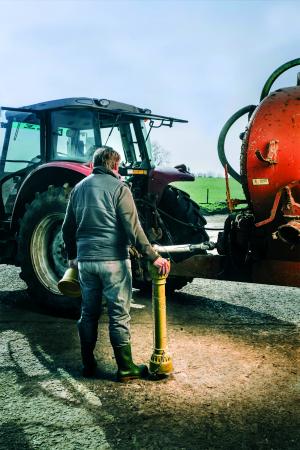PTO guarding - the basics
'Power-take-off' shafts (PTOs) are the power source for many machines attached to and powered by tractors - shafts can rotate at speeds up to 1000 rpm.

All PTO shafts need to be properly guarded
Guards need to be kept in good condition and used properly - it could save your life.
Broken, damaged or badly fitting PTO guards are as dangerous as an unguarded PTO shaft and can easily give a false sense of security and so increase the danger.
Remember, never wear loose clothes when operating machines powered by PTOs.
Operators and drivers should know how to operate and look after their machines safely.
Equipment that is not maintained properly can cause accidents so never take chances by using poorly maintained or faulty equipment, even for the smallest job.
Every year people are seriously injured in accidents involving PTO shafts - accidents that are potentially fatal.
These accidents are preventable if the PTO and PTO drive shaft are fitted with proper guards which are correctly used and maintained.
Use the proper type of guard
It is very difficult to select the best PTO guard to suit your needs simply by looking at the guard in a shop.
Before buying a new guard it is wise to speak to a reputable machinery dealer or agricultural engineer/mechanic as they can advise on the type and make of guard that should suit your needs.
A few tips to help select a suitable guard include:
- selecting a guard with flexible end cones
- a heavy duty plastic telescopic section
- a guard which can be easily removed and replaced to allow regular maintenance
PTO drive shafts should be enclosed with guards along their full length from the tractor to the first bearing on the machine.
It is essential that the groove in the yoke of the PTO shaft is clean, undamaged and in good condition and the correct bearing ring is fitted so the PTO shaft guard and bearings can turn freely.
A broken, damaged or badly fitting PTO guard can be just as dangerous as no guard at all.
PTO maintenance
- lubricate the bearings regularly as recommended by the manufacturer - do not over grease the bearing as the excess grease will attract dirt and dust
- clean the inner and outer sliding surfaces of the telescopic section of the guard daily or more frequently if the manufacturer recommends it - do not lubricate the sliding section of the guard with grease unless the manufacturer recommends it
- regularly remove the guard and clean the shaft with penetrating oil
- make sure that the U-guard on the tractor is in good condition. If it is bent it can damage the end of the PTO guard
- make sure that the O-guard fitted to the implement is the correct size to suit the PTO guard
- make sure that the U-guard on the tractor and the O-guard on the implement overlap the PTO shaft guard by at least 50mm
- make sure that the PTO shaft and guard are the correct length for the machine - the PTO guard telescopic section should be slightly shorter (not by more than 25mm) than the length of the telescopic halves of the PTO drive shaft
- lubricate the sliding metal PTO drive shafts as recommended by the manufacturer (usually before starting work and after every eight hours of use)
- make sure that the button on the end of the PTO shaft moves freely as the shaft and guard can be damaged if the button or the end of the shaft is hammered into position
- keep the tractor rear lower lift arms in a position to avoid them striking the PTO shaft or guard when the tractor is turning - if making tight turns reduce the PTO speed or disengage the PTO drive to protect the shaft
- keep the restraining chains in place and secure them to a suitable point on the tractor and implement - this is usually near to the O-guard on the machine and the U-guard on the tractor (this makes sure that there is no restriction in the movement of the chains) - do not attach the end of the chain to the lower lift arms
- if using a bellows type PTO guard make sure that the ends of the guard are held correctly in place at both the tractor and implement, to ensure the drive shaft is fully enclosed in the guard and replace if necessary
- if buying a new PTO shaft for heavy drive machines, for example forage harvester, mower, feeder wagon or rotavator, make sure the shaft is heavy duty and suitable for the job
- consider fitting a PTO shaft with a wide-angle universal joint on machines like balers, mowers and slurry tankers
- make sure that draw-bar pins on trailed machines do not foul and damage the shaft or guard.
It is important that the other drive shafts on machines are guarded as well.
For a demonstration of the potential dangers of what an unguarded PTO can do, please watch the following video on our YouTube channel.
